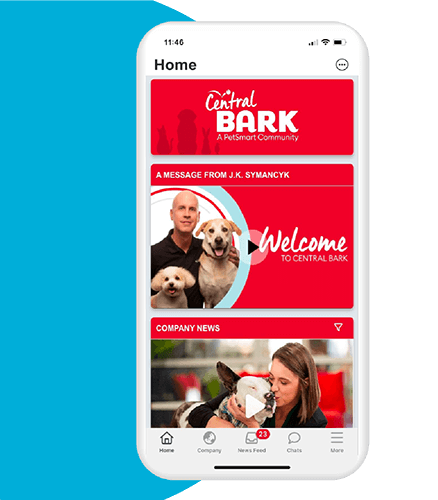In today’s retail landscape, staff training is paramount to success. With the right training processes in place, employees can deliver excellent customer service, enhance the shopping experience, and significantly boost sales figures. But how can businesses ensure they provide top-notch training? The answer lies in leveraging smart solutions, such as an employee app for retail.
Our technology-driven world offers an array of sophisticated tools and platforms that can revolutionize retail staff training. These smart solutions can streamline and personalize the training process. They also provide real-time analytics and feedback, setting the groundwork for continuous improvement. They enable businesses to move beyond traditional training methods and make learning more engaging, efficient, and impactful.
In this article, we unveil the transformative potential of implementing smart solutions in retail staff training. We will delve into the features, benefits, and successful application of these advanced training tools, providing exhaustive insights to optimize your staff training strategies. Join us on this journey to explore how smart solutions can elevate your retail business to new heights.
Understanding Retail Staff Training Needs
Before we dive into how tech solutions can enhance retail staff training, let’s explore this sector’s unique needs and challenges. Just like every retail business is unique, so are its training needs. Therefore, a one-size-fits-all approach is simply not adequate.
Rigorous understanding of retail staff training needs is the bedrock upon which you can build an effective strategy. In the following sections, we will dissect the key factors that shape these needs, explore the common hurdles faced in traditional training methods, and elucidate why smart solutions are the way forward.
Addressing the Challenges of a Dispersed Frontline Workforce
In a large retail chain, it’s not easy to ensure consistent training across a large, spread out frontline workforce. With employees distributed across various geographical locations, standardizing the training process becomes a daunting task. Moreover, the diversity in regional demographics, customer preferences, and local market dynamics further complicate the training needs.
In such a scenario, the traditional in-person training methods fall short. They require substantial time and resources and struggle to cater to the unique local nuances of each store. For instance, a training module designed for a store in a bustling urban location might prove ineffective for a store situated in a rural setting. Furthermore, the logistical challenges of scheduling and conducting regular training sessions across multiple locations are indeed overwhelming.
Accessibility of Training
Another significant challenge arises when online training is available only at a shared desktop. This style of training can limit accessibility and flexibility for the employees, posing a considerable hindrance to learning. For example, employees may struggle to find quiet and uninterrupted time at the shared desktop for their training. Furthermore, they may be unable to progress at their own pace or revisit training modules.
This style of training also falls short in accommodating for the varying schedules of employees, particularly in shift work. For online training to truly work in retail, it must offer a level of flexibility and personal accessibility. A shared desktop simply does not provide this.
Another critical concern for retail chains is maintaining communication and engagement with the frontline staff. The larger the workforce, the more pronounced is the risk of communication gaps and inconsistencies—see our list of common communication problems in retail. All employees, regardless of their location, should stay informed and aligned with the company’s objectives, policies, and updates. This becomes particularly challenging when dealing with a mix of full-time, part-time, and seasonal staff.
Therefore, to effectively manage the training needs of a large, dispersed frontline workforce, retail businesses need a better solution. This is where the power of smart solutions come into play. They provide the opportunity to standardize training while also allowing for localization, engagement, and consistent brand experience across all stores.

PetSmart Case Study
Learn how PetSmart has achieved 4x the industry standard for employee engagement with a mobile-first platform built on MangoApps.
The Challenge of Scalability
Scalability is a crucial factor when it comes to retail staff training. As businesses grow and expand, their training needs evolve too. The need for a system that can adapt to this growth should be a core element of any retail training strategy.
Traditional training methods can struggle to keep up with the pace of business expansion. Logistical burdens such as arranging for trainers, coordinating schedules, creating physical training materials, and arranging for suitable session venues can become insurmountable. This rigidity and lack of adaptability make traditional training methods less than ideal for a rapidly growing retail business.
In contrast, smart solutions offer the flexibility and scalability that modern retail businesses require. With cloud-based platforms, businesses can easily manage and disseminate training programs to a large team with just a few clicks. They can effortlessly update training content to keep up with changing business needs and market dynamics. Moreover, they provide the convenience of mobile learning, enabling employees to access training materials anytime and anywhere, thereby reducing downtime and increasing productivity.
Content Personalization
Furthermore, smart solutions offer scalability in terms of content personalization. They enable businesses to create individual learning paths based on the unique needs and progress of each employee. This level of personalization improves engagement, retention, and ultimately, the effectiveness of the training. A good training program goes hand in hand with your employee engagement strategy.
Smart solutions also offer scalability in terms of analytics. They provide businesses with the tools to monitor and analyze the effectiveness of their training programs on a large scale. With real-time analytics, businesses can promptly identify gaps in training, areas of improvement, and track progress over time. This kind of data-driven approach ensures continuous improvement and optimization of retail staff training.
In essence, scalability is not just about accommodating more employees or more stores. It’s about growing and adapting in a way that makes training more effective, personalized, and strategically aligned with business objectives. It’s about leveraging technology to make training a driving force for business growth. And this is precisely what smart solutions offer.
Keeping Pace with Retail Trends
Keeping pace with emerging retail trends is important for staying competitive and providing up-to-date, relevant training to staff. The retail industry undergoes rapid changes, with new technologies, consumer behaviors, and market trends constantly shaping the retail landscape. In turn, these changes necessitate continual updates to training programs. This is crucial to equip employees with the knowledge and skills needed to thrive in the evolving retail environment.
The rise of e-commerce, for example, has significantly transformed retail operations. As consumers opt for online shopping, retail staff need to manage online orders, inquiries, and interfaces. Staff must also be adept at offering high-quality virtual customer service, as the online platform becomes a crucial touchpoint for customer interaction.
Moreover, there is a shift towards omnichannel retailing—a seamless integration of physical and online shopping experiences. Employees must understand the intricacies of an omnichannel strategy, including inventory management, order fulfillment, and unified customer experience across all channels.
Changing Consumer Behaviors
In addition to these technological shifts, changing consumer behaviors also alter the retail landscape. For instance, the increasing demand for sustainability has led many retailers to adopt eco-friendly practices. Employees must be trained not only in implementing these practices but also in effectively communicating them to customers.
Lastly, the impact of global events, such as the COVID-19 pandemic, underscores the need for agility in retail training. The pandemic brought about unforeseen changes in retail operations, from enforcing health and safety protocols to managing supply chain disruptions. It highlighted the need for rapid, responsive training that can equip staff to navigate unexpected situations and emerging challenges.
Therefore, in the dynamic world of retail, training solutions must adapt to ever-changing trends and demands. Smart solutions excel in this area. They facilitate easy and immediate updates to training content, ensuring that the training program evolves in tandem with the retail landscape. They also allow for immediate dissemination of new information or procedures, ensuring that all staff are promptly informed and trained.
By staying abreast with retail trends and integrating them into the training program, retail businesses can ensure that their staff are always prepared, competent, and confident in delivering excellent service, no matter what changes come their way.
Store Clerk Knowledge
The role of a store clerk goes well beyond the traditional responsibilities of stocking shelves and operating tills. In today’s retail environment, a store clerk is a vital link between a business and its customers. They interact with customers on the shop floor, providing product information, handling queries, and offering professional, tailored advice. Therefore, the depth and breadth of a store clerk’s knowledge can significantly impact customer satisfaction, sales, and overall business performance.
Firstly, product knowledge is critical. Store clerks should have an extensive understanding of the products they sell, from features and benefits to the specific needs they fulfill. This includes understanding product specifications, knowing how to use and maintain the products, and being aware of any safety considerations. It also entails an understanding of the product’s value proposition and how it compares to competitors. With comprehensive product knowledge, store clerks can confidently advise customers, helping them make informed purchase decisions and fostering trust in the brand.
Secondly, store clerks should understand the company’s policies and procedures. This includes return and exchange policies, warranty information, promotional offers, loyalty programs, and more. By being well-versed in the company’s policies, store clerks can efficiently handle customer inquiries and issues, promoting a smooth, hassle-free shopping experience.
Thirdly, familiarity with the store’s layout and inventory is vital. Store clerks should know where products are located and be able to guide customers to their desired items quickly. They should also be aware of inventory levels, enabling them to inform customers about product availability and provide information on when out-of-stock items will be replenished.
Technical and Interpersonal Skills
Furthermore, in an era where retail is increasingly digital, store clerks should possess technical skills to handle online orders, process digital payments, and manage customer data. They should be comfortable using point-of-sale systems, inventory management software, and other retail technologies.
Lastly, interpersonal skills form a crucial part of a store clerk’s knowledge. From communication and listening skills to patience and empathy, these soft skills enable store clerks to provide excellent customer service. They foster positive interaction with customers, helping to build loyal relationships and enhance the brand’s reputation.
In sum, investing in the comprehensive training of store clerks is vital for a successful retail business. Smart solutions offer a flexible, efficient, and effective platform for delivering such training, ensuring that store clerks are equipped with the knowledge and skills they need to excel in their roles. By empowering store clerks, retail businesses can enhance customer satisfaction, boost sales, and drive business growth.
Common Challenges in Retail Staff Training
Despite the crucial role of retail staff training in enabling business success, implementing it effectively comes with its own set of challenges. These obstacles can range from maintaining engagement during training sessions to ensuring the acquired knowledge is retained and applied effectively.
In this section, we delve into these common challenges faced by retail businesses and how smart solutions can help overcome them, bolstering the overall efficiency and effectiveness of your retail staff training program. Let’s explore these challenges in more detail.
Time Constraints and Scheduling Conflicts
One of the most prevalent challenges in retail staff training is managing time constraints and scheduling conflicts. Retail businesses operate on tight schedules, with staff members working in shifts and often juggling multiple tasks. This makes it difficult to allocate adequate time for training without disrupting daily operations or compromising customer service. Furthermore, as retail staff often work irregular hours, coordinating training sessions that suit everyone’s schedules can be a complex and time-consuming task.
Also, traditional training methods, such as classroom-based sessions or workshops, are often lengthy and cannot be easily adjusted to align with the sporadic, fast-paced nature of retail work. They require staff to be physically present at a specific time and place, which can be particularly challenging for stores with multiple locations or for employees who work part-time or irregular hours.
Inconsistency in Training Quality
Another challenge encountered in retail staff training is the inconsistency in training quality. This issue often arises when different trainers or managers conduct the training sessions. Each individual may have their own teaching style, focus on different aspects of the job, or communicate the material differently. This variability can lead to disparities in knowledge and skills among staff members, which can impact the consistency of service delivered to customers.
Inconsistency in training quality can also occur when updates or changes to procedures, policies, or products are not communicated promptly or are communicated without sufficient detail and clarity. This can leave staff members ill-equipped to perform their roles effectively and could lead to customer dissatisfaction.
Moreover, the quality of the training material itself can contribute to this inconsistency. Outdated, inaccurate, or poorly structured training material can confuse trainees or provide them with incorrect information, which is counterproductive.
The lack of personalization in training is another factor that can affect the quality. Not every staff member has the same level of experience, knowledge, or learning pace. Training programs that do not take these individual differences into account may fail to meet each staff member’s unique learning needs, leading to gaps in knowledge or skills.
Measuring Training Effectiveness
Determining the effectiveness of retail staff training is a significant challenge for many businesses. To ensure that the training program is delivering the desired results, businesses must be able to measure its impact on employee performance, customer satisfaction, and overall business outcomes. However, evaluating these parameters is often difficult due to the lack of proper assessment tools and metrics.
Traditional evaluation methods, such as feedback surveys or quizzes, may not provide a comprehensive picture of the training’s effectiveness. These methods generally focus on measuring trainees’ satisfaction with the training or their recall of the information presented, rather than assessing whether they can apply the learned skills and knowledge in real-world scenarios.
Moreover, trainees might not always be truthful or accurate in their self-assessments, which can lead to skewed results. Even when performance assessments are carried out, they often rely on subjective observations and judgments, which can vary greatly among different evaluators.
The evaluation process can be further complicated by the diverse range of roles and responsibilities within a retail environment. Each role requires a unique set of skills and knowledge, making it challenging to develop a one-size-fits-all assessment strategy. Businesses need to define specific performance indicators for each role and ensure that these indicators are measured consistently to accurately evaluate the training’s effectiveness.
The Challenge of Timing
Another hurdle in measuring training effectiveness is the time lag between training and observable changes in performance and business outcomes. It may take weeks or even months before the impact of training becomes evident. This delay makes it difficult for businesses to promptly identify and address any issues with the training program. Furthermore, other factors, such as changes in market conditions, store layout, or customer demographics, can influence business outcomes, making it challenging to isolate the training’s impact.
To overcome these challenges, businesses need to adopt a robust, systematic approach to training evaluation. This involves clearly defining the objectives of the training program, establishing relevant performance indicators, using a mix of assessment methods to capture different aspects of learning, and regularly reviewing and refining the evaluation strategy based on feedback and results. Using technology-based solutions, such as e-learning platforms or employee performance management software, can facilitate this process by providing tools for tracking and analyzing learning outcomes and performance metrics in real-time. By leveraging these solutions, retail businesses can ensure their training program is effective, relevant, and contributing to their success.

Great Harvest Case Study
Learn how Great Harvest uses MangoApps to provide store owners a place to collaborate and share knowledge, ideas, and information.
Reaching Frontline Employees
In many retail businesses, frontline employees are the face of the company, interacting directly with customers and delivering the service that defines the customer’s perception of the brand. Therefore, effectively reaching and training these employees is of paramount importance.
However, training frontline staff presents its own set of unique challenges. Frequency of staff turnover in retail is often high, and new employees need to be brought up to speed quickly. This need for rapid training can conflict with the desire to provide comprehensive, in-depth training that properly equips employees to excel in their roles.
In addition, frontline staff often have limited time for training due to the demanding nature of their roles. Balancing the time for training with their core responsibilities of serving customers becomes a daunting task. Traditional training methods may involve taking staff away from their roles for long periods, which isn’t always feasible in a fast-paced retail environment.
Moreover, the geographical spread of retail stores can make it difficult to deliver consistent training across all locations. Traditional face-to-face training methods are often not practical for companies with stores spread across wide geographical areas.
Diverse Roles Add Complexity
The diversity of frontline roles in retail also adds complexity to training. From cashiers to sales assistants, each role requires a unique set of skills and knowledge. This diversity requires a flexible training approach that can cater to the specific needs of each role.
Overcoming these challenges requires a shift in the training approach. Retail businesses need to adopt flexible, scalable training solutions that can meet the unique needs of frontline staff. One such solution is online training, which offers the flexibility for employees to learn at their own pace and in their own time. Online training platforms can also provide interactive, engaging learning experiences that can enhance knowledge retention and application.
Furthermore, adopting a blended learning approach can also be beneficial. This combines online learning with face-to-face sessions, allowing for the advantages of both methods. It allows for consistent delivery of training material across all locations, while still providing the opportunity for hands-on practice and personalized feedback.
In conclusion, reaching and effectively training frontline employees is crucial for retail businesses. By adopting flexible, modern training methods, retail businesses can ensure their staff are well-equipped to deliver exceptional customer service, promoting customer satisfaction and loyalty, and ultimately driving business success.
Leveraging Technology for Enhanced Training
In today’s digital age, the role of technology in shaping retail staff training can’t be overstated. Dynamic, interactive, and versatile, technology has the potential to revolutionize how retail staff are trained, leading to greater efficiencies, improved learning outcomes, and ultimately, superior customer service.
One of the significant advantages of technology-based training is its accessibility. With e-learning platforms, employees can access training material anytime, anywhere, making it easier for businesses to deliver consistent training across all locations. This flexibility also allows for personalized learning experiences that cater to individual employee needs and preferences.
Moreover, technology-based solutions offer a variety of tools and features that enhance the learning experience
Our Approach to Empowering Retail Staff Training
At MangoApps, we understand the unique challenges and opportunities of retail staff training. As a leading provider of digital workplace solutions, our platform is designed to support and enhance your training initiatives. Our robust, user-friendly platform enables you to deliver interactive, engaging training programs that can be accessed anytime, anywhere.
With MangoApps, training is no longer a one-size-fits-all approach. You can customize content to cater to the diverse roles within your retail business, ensuring every employee receives relevant, targeted training. Our platform also facilitates real-time feedback and performance tracking, allowing you to monitor progress and adjust training as needed.
Think of MangoApps as your one-stop solution for all your retail staff training needs. From onboarding new hires to upskilling existing employees, our platform empowers you to deliver effective training that can drive growth, customer satisfaction, and success in the competitive retail landscape. And as retail evolves, we evolve with it, continually updating our platform to meet your emerging needs.
Accessibility and Integration
The accessibility of MangoApps on mobile devices further enhances the effectiveness of our retail staff training solutions. Retail associates are invariably on the move, making a mobile-first approach critical in today’s fast-paced retail environment. With MangoApps effortlessly integrated into an app that your employees already use, we overcome many of the traditional limitations of training. This feature allows your frontline staff to access training modules and updates wherever they are, at a time that works best for them.
Moreover, distributing new information quickly becomes a breeze. Need to roll out a new product tutorial, a policy change, or a promotional update? It can be done in moments, reaching your entire retail staff almost instantly. The mobile accessibility of our platform ensures that your team has the latest information at their fingertips, helping them to consistently deliver excellent customer service.
Best of all, this approach eliminates the need to train your team on an additional platform or rely on them using shared devices. The ease of using a familiar app significantly reduces the learning curve, encouraging higher engagement and consistent use. This focus on user-friendliness and accessibility underscores our commitment to empowering your retail staff training, making it as intuitive, effective, and seamless as possible.
Conclusion
In summary, the challenges in retail staff training are numerous, but with the right technology and approach, these can be transformed into opportunities for growth and improvement. We encourage retail chains to consider how technology, especially a comprehensive and integrated training solution, can revolutionize their staff training processes.
For more, read about retail execution monitoring, our guide to combating retail turnover, or effective communication strategies. You can also look into our employee app for retail, or see customer stories from PetSmart, Superdrug, and A.S. Watson.







